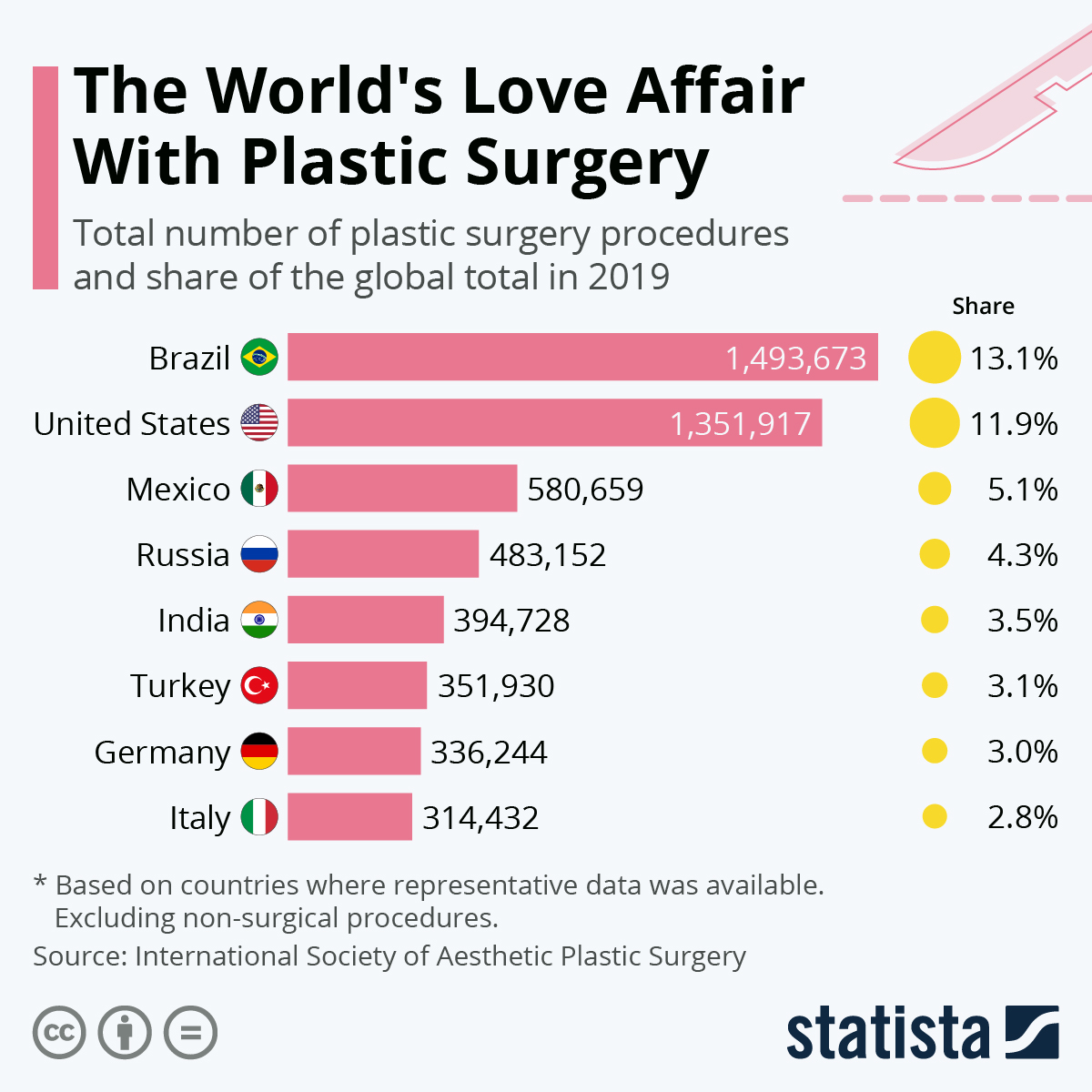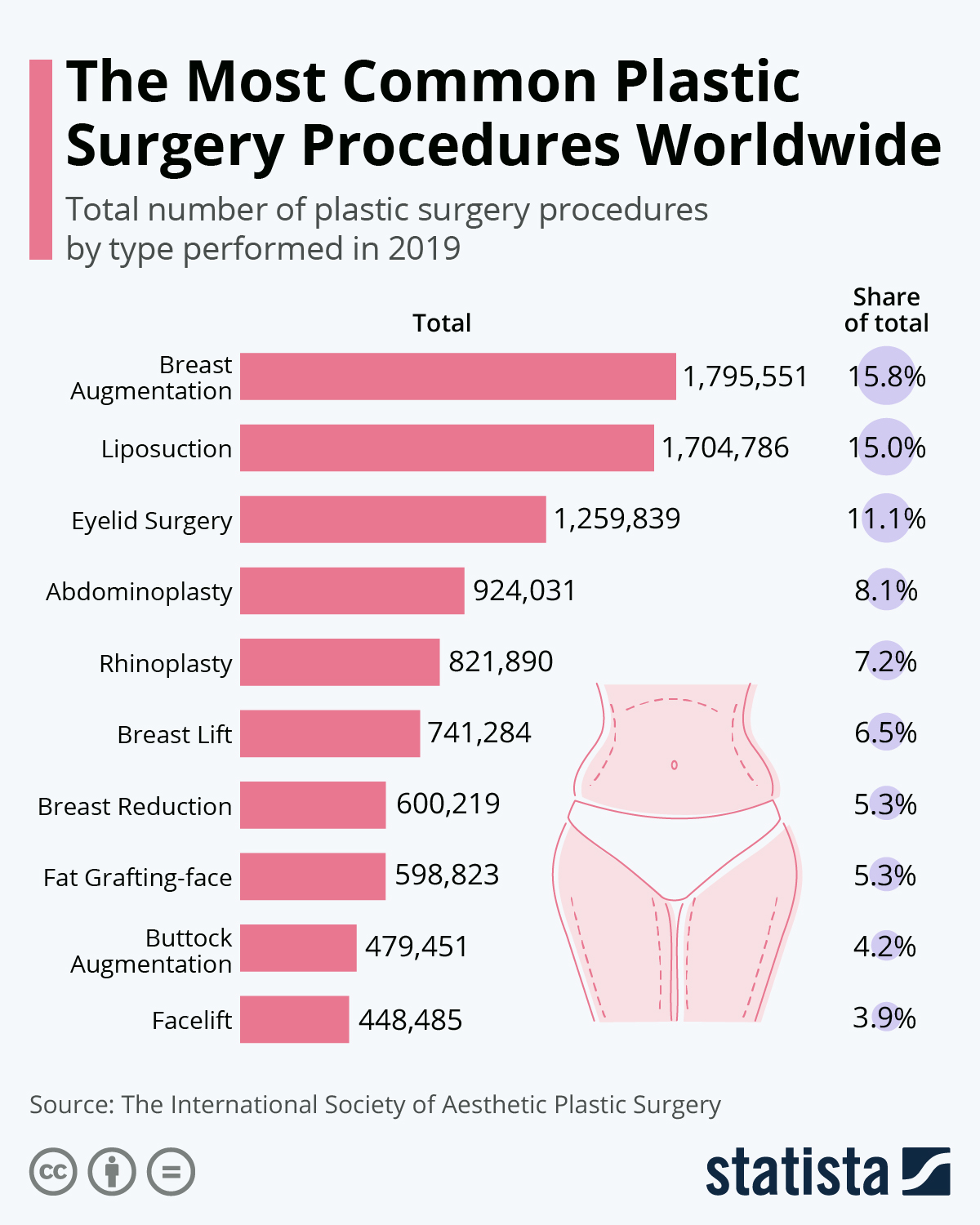Plastic Surgery Statistics, Facts and Prevalence
Discover the latest plastic surgery statistics, debunking myths and shedding light on trends. Get informed and make empowered choices.
Plastic Surgery Statistics: An Overview
Plastic surgery statistics provide valuable insights into the ever-evolving field of cosmetic enhancements. By analyzing these statistics, we can gain a better understanding of the scope, trends, and factors influencing plastic surgery practices.

Plastic Surgery Statistics
- According to the American Society of Plastic Surgeons, the number of cosmetic procedures performed in the United States increased by 2% from 2018 to 2019.
- The most popular cosmetic surgical procedure in the United States in 2019 was breast augmentation, with over 300,000 procedures performed.
- Liposuction was the second most popular cosmetic surgical procedure in the United States in 2019, with over 265,000 procedures performed.
- In 2019, Americans spent over $16.5 billion on cosmetic procedures, including both surgical and non-surgical treatments.
- The average cost of breast augmentation in the United States is around $3,800.
- The average cost of liposuction in the United States is around $3,500.
- According to a survey by RealSelf, a website that provides information and reviews on cosmetic procedures, 83% of women and 72% of men who are considering plastic surgery research the procedure online before scheduling a consultation.
- In a survey of plastic surgeons conducted by the American Society of Plastic Surgeons, 93% reported using social media for professional purposes.
- A study published in JAMA Facial Plastic Surgery found that using a smartphone for taking selfies can distort facial features and make the nose appear larger than it actually is.
- According to a survey by the American Academy of Facial Plastic and Reconstructive Surgery, rhinoplasty (nose surgery) is becoming increasingly popular among millennials, with 64% of facial plastic surgeons reporting an increase in requests for the procedure from this demographic.
The Scope of Plastic Surgery
Plastic surgery encompasses a wide range of procedures aimed at enhancing various aspects of physical appearance. These procedures can be broadly categorized into two types: reconstructive and cosmetic surgery.
Reconstructive surgery focuses on restoring or improving bodily functions and correcting abnormalities resulting from congenital conditions, accidents, or medical treatments. Examples of reconstructive procedures include breast reconstruction, scar revision, and cleft palate repair.
On the other hand, cosmetic surgery is elective and primarily focused on enhancing aesthetic appeal. It includes procedures such as breast augmentation, liposuction, and rhinoplasty. These procedures aim to reshape or refine specific features to achieve the desired aesthetic outcome.
Global Plastic Surgery Statistics
- According to the International Society of Aesthetic Plastic Surgery (ISAPS), there were approximately 28.4 million surgical and non-surgical cosmetic procedures performed worldwide in 2019.
- The United States held the highest number of cosmetic procedures, followed by Brazil, Japan, South Korea, and Mexico.
- In 2019, breast augmentation was also the most popular surgical procedure globally, while botulinum toxin (Botox) injections topped the list for non-surgical treatments.
- Asia has seen a significant increase in demand for plastic surgery over the past decade, with countries such as South Korea and China experiencing exponential growth in various cosmetic procedures.
- In Europe, Germany, France, and Italy are among the top countries with high numbers of cosmetic surgeries performed.
- Cultural influences play a key role in determining popular procedures across different regions. For example, double eyelid surgery is highly sought after in East Asian countries to create a more prominent crease above the eye.
- Medical tourism is an emerging trend in the global plastic surgery market as patients seek more affordable options or specialized expertise available in other countries.
These global statistics highlight how diverse and widespread plastic surgery has become around the world. They also underscore that cultural factors significantly influence trends within different regions and contribute to shaping this dynamic field's evolution internationally.

United States Plastic Surgery Demographics
- Women account for approximately 92% of all cosmetic procedures performed in the United States, while men represent around 8%.
- In 2019, the age group with the highest number of cosmetic procedures was between 40 and 54 years old, representing 49% of all patients.
- Individuals aged between 30 and 39 years accounted for 29% of cosmetic procedures in the same year.
- The most common ethnic background among plastic surgery patients in the United States is Caucasian, representing around 70% of all cases. However, there has been a steady increase in plastic surgery among other ethnic groups such as African Americans, Hispanics, and Asians.
- Geographic location plays a significant role in determining plastic surgery trends within the United States. For instance, states like California and New York have higher rates of cosmetic procedures compared to more rural areas.
Nonsurgical Cosmetic Procedures in the United States
- In addition to surgical treatments, nonsurgical cosmetic procedures have gained immense popularity over recent years due to their less invasive nature and shorter recovery times.
- In 2019, botulinum toxin injections (Botox) were recorded as the most popular nonsurgical treatment with approximately 7 million procedures performed across the country.
- Soft tissue fillers ranked second on the list with over 2.7 million treatments performed in that year.
- Chemical peels were another prominent nonsurgical treatment option with nearly 1.3 million procedures undertaken in 2019.
These additional statistics further demonstrate how diverse and pervasive plastic surgery has become within the United States alone while also highlighting key demographic factors that influence both surgical and nonsurgical cosmetic procedure trends nationwide.
Differences in Plastic Surgery Practices Across Countries
While plastic surgery is a common practice worldwide, there are notable differences in its practices across countries.
- In South Korea, the prevalence of plastic surgery is exceptionally high, with an estimated 20% of women having undergone cosmetic procedures.
- Brazil has the highest number of plastic surgeons per capita globally, with around 5,500 board-certified professionals in the country.
- Japan has seen a surge in non-surgical treatments such as injectables and laser therapy, accounting for approximately 60% of all cosmetic procedures performed in the country.
- According to a study by The Lancet, Iran ranks first globally for rhinoplasty per capita, with about 7.2 procedures per 1,000 people annually.
- In India, hair transplant surgeries have gained significant popularity in recent years, with an estimated growth rate of 25% annually for this specific procedure.
- The United Kingdom saw a decline in cosmetic surgeries by about 8% between 2015 and 2016 but experienced growth in non-surgical treatments such as dermal fillers and Botox injections during the same period.
- In Australia, breast augmentation remains a highly popular procedure; however, there has also been a notable increase in non-invasive body contouring treatments like CoolSculpting and SculpSure.
- In France and Italy, facial rejuvenation procedures such as facelifts and eyelid surgeries have remained consistently popular among patients seeking surgical cosmetic enhancements.
These variations highlight the complex interplay between cultural norms, economic factors, government policies, and individual preferences that shape plastic surgery practices globally.
Prevalence of Plastic Surgery
Plastic surgery has become increasingly prevalent in recent years. According to the American Society of Plastic Surgeons:
- Over 18 million cosmetic procedures were performed in the United States in 2019.
- A significant portion of these procedures were non-surgical, such as Botox and fillers.
- There was a 2% increase in cosmetic procedures from the previous year.
- There has been a 163% increase in cosmetic procedures since the year 2000.
While plastic surgery was once considered a luxury reserved for the wealthy elite, it has become more accessible and affordable in recent years. The rise of medical tourism, where patients travel to other countries for cheaper cosmetic procedures, has also contributed to the growing prevalence of plastic surgery.
However, it is important to note that plastic surgery is not without risks. As with any surgical procedure, there are potential complications and side effects that must be carefully considered before undergoing treatment. It is essential for patients to research their options thoroughly and consult with qualified professionals before making any decisions regarding plastic surgery.
Why People Choose Plastic Surgery?
- A study conducted by the American Society of Plastic Surgeons revealed that 62% of patients sought plastic surgery to improve their self-esteem and confidence.
- Approximately 47% of individuals opt for plastic surgery to enhance their physical appearance and achieve a more youthful look.
- Around 37% of patients undergo cosmetic procedures to correct physical imperfections or deformities caused by accidents, illnesses, or congenital conditions.
- About 29% of people choose plastic surgery as a means to reduce the visible signs of aging, such as wrinkles and sagging skin.
- An estimated 21% of patients pursue cosmetic procedures following significant weight loss, aiming to remove excess skin and reshape their bodies.
- Roughly 15% of individuals decide on plastic surgery due to social or cultural pressures and the desire to conform to particular beauty standards prevalent in their communities.
- Nearly 12% of people opt for cosmetic enhancements as part of post-cancer recovery treatments, such as breast reconstruction after mastectomy.
The Benefits of Plastic Surgery
Plastic surgery offers numerous benefits beyond just physical appearance. These benefits can positively impact a person's emotional and mental well-being as well.
- Increased Self-Confidence: Many people who undergo plastic surgery report feeling more confident and self-assured after the procedure. This boost in confidence can have a ripple effect that extends to other areas of their life, such as relationships and career opportunities.
- Improved Physical Health: Certain plastic surgery procedures, such as breast reduction or rhinoplasty, can improve physical health by alleviating chronic pain or breathing difficulties.
- Better Mental Health: Plastic surgery has been shown to improve mental health by reducing symptoms of anxiety and depression. For example, breast reconstruction after mastectomy can help women feel more positive about their bodies and reduce feelings of depression.
- Enhanced Quality of Life: By improving physical appearance and increasing self-confidence, plastic surgery can enhance overall quality of life for many patients.
It is important to note that while plastic surgery can offer numerous benefits, it should not be seen as a cure-all for deeper emotional issues or self-esteem problems. It is always recommended to consult with a qualified medical professional before undergoing any cosmetic procedure to ensure the best possible outcome.
Impact of Social Media and Celebrity Culture
Social media and celebrity culture heavily influence plastic surgery trends. Statistics show that people compare themselves to idealized standards on social media, leading to an increased interest in plastic surgery. Additionally, celebrities' openness about undergoing plastic surgery has further normalized these procedures. However, individuals should approach plastic surgery with caution and make informed decisions based on personal desires and needs. Thorough research and consultation with qualified professionals are essential. Examining plastic surgery statistics provides valuable insights into individuals' motivations and the impact of societal factors on their decisions. It's crucial to approach plastic surgery with a well-informed and realistic mindset as part of the journey to self-acceptance and well-being.
Trends in Plastic Surgery
As the field of plastic surgery continues to evolve, it is important to examine the trends and patterns in procedures and the shifting demographics of those seeking these treatments.

Popular Procedures
Plastic surgery encompasses a wide range of procedures aimed at enhancing and altering various aspects of the body. Some of the most popular plastic surgery procedures include:
Procedure and Description
- Breast Augmentation: Enhancing breast size and shape through the use of implants or fat transfer.
- Liposuction: Removing excess fat deposits to sculpt and contour the body.
- Rhinoplasty: Reshaping the nose to improve its appearance or functionality.
- Eyelid Surgery: Correcting drooping eyelids or reducing under-eye bags for a more youthful look.
- Facelift: Reducing signs of aging by tightening facial muscles and removing excess skin.
- Botox Injections: Temporarily reducing the appearance of wrinkles and fine lines through the use of botulinum toxin.
These procedures continue to be sought after by individuals looking to enhance their physical appearance or address specific concerns.
Shifting Demographics
Plastic surgery is no longer just for women. Men are seeking procedures to boost their self-confidence and improve their appearance. Younger patients are also getting in on the trend, influenced by social media and a desire to stay youthful. It's important to stay informed about the latest trends and weigh the risks and benefits of these procedures.
Factors Influencing Plastic Surgery Trends
The trends in plastic surgery are influenced by a variety of factors, including cultural and social influences, as well as advancements in technology and techniques. These factors shape the evolving landscape of plastic surgery and contribute to the changing preferences and demands of patients.
Cultural and Social Influences
Cultural and social influences play a significant role in shaping the trends in plastic surgery. Beauty standards and ideals vary across different cultures and societies, impacting the types of procedures that are popular in specific regions. For example, in some cultures, certain facial features or body proportions may be considered more desirable, leading to an increased demand for procedures like rhinoplasty or breast augmentation.
Moreover, societal attitudes towards aging and body image also influence plastic surgery trends. As people strive to maintain a youthful appearance and enhance their self-confidence, procedures such as facelifts and body contouring gain popularity. The influence of media, including advertising, television, and social media, further amplifies these cultural and social factors. Individuals are exposed to images of idealized beauty, leading them to seek procedures that help them align with these standards.
Advancements in Technology and Techniques
Advancements in plastic surgery have revolutionized the field, driving the emergence of new trends. Innovations in surgical tools, anesthesia, and imaging technologies have improved the safety and precision of procedures. Non-surgical options like Botox and dermal fillers have gained popularity for their subtle improvements without surgery. Understanding trends is essential for informed decisions about desired procedures.
Debunking Myths about Plastic Surgery
Plastic surgery has become a widely discussed topic, often surrounded by various myths and misconceptions. In this section, we aim to debunk two common myths associated with plastic surgery: unrealistic expectations and risks and benefits.
Unrealistic Expectations
One prevalent myth about plastic surgery is that it can completely transform an individual's appearance to match an unrealistic ideal. While plastic surgery can enhance and improve certain features, it is essential to have realistic expectations. The outcome of any procedure may vary depending on factors such as individual anatomy, healing process, and surgical techniques.
It is crucial for individuals considering plastic surgery to have open and honest conversations with their surgeon. This helps to set realistic goals and understand the limitations of the procedures. Surgeons can provide valuable insights into what can be achieved and guide patients towards making informed decisions. Exploring before and after photos of similar procedures can also provide a better understanding of what to expect.
Conclusion
Plastic surgery has become a popular option for individuals looking to enhance their physical appearance or address specific concerns. The trends in plastic surgery are influenced by various factors, including cultural and social influences, as well as advancements in technology and techniques. As the field of plastic surgery continues to evolve, it is essential to stay informed about the latest trends and weigh the risks and benefits of these procedures.
Examining plastic surgery statistics provides valuable insights into individuals' motivations and the impact of societal factors on their decisions. Social media and celebrity culture heavily influence plastic surgery trends, leading people to compare themselves with idealized standards. However, it's important to approach plastic surgery with caution and make informed decisions based on personal desires and needs.
Debunking myths associated with plastic surgery is crucial to avoid disappointment. Recognizing limitations and complications can help individuals set realistic expectations for their desired outcomes. By approaching plastic surgery with a well-informed mindset, individuals can embark on a journey towards self-acceptance and well-being.
In conclusion, understanding the trends in plastic surgery provides valuable insights into the changing landscape of beauty. It is essential to approach cosmetic procedures with realistic expectations, thorough research, consultation with qualified professionals who prioritize safety above all else. With this approach, individuals can achieve their desired results while prioritizing their health and well-being.
Sources
Find Your Inner Light
Related Articles
Contact Us
Leora Behavioral Health offers a comprehensive addiction treatment programs to help you get your life back on track.
Our trained professionals will work with you to develop a personalized treatment plan that meets your unique needs. If you or someone you know is struggling with addiction, reach out to Leora Behavioral Health today.


.svg)





.svg)
.svg)
.svg)
.svg)